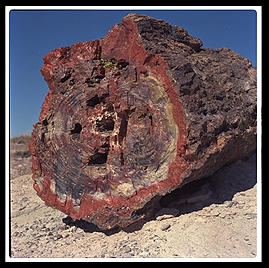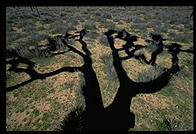

|
Trees in Oracle SQLpart of SQL for Web Nerds by Philip Greenspun |
 On its face, the relational database management system would appear to
be a very poor tool for representing and manipulating trees. This
chapter is designed to accomplish the following things:
On its face, the relational database management system would appear to
be a very poor tool for representing and manipulating trees. This
chapter is designed to accomplish the following things:
create table corporate_slaves ( slave_id integer primary key, supervisor_id references corporate_slaves, name varchar(100) ); insert into corporate_slaves values (1, NULL, 'Big Boss Man'); insert into corporate_slaves values (2, 1, 'VP Marketing'); insert into corporate_slaves values (3, 1, 'VP Sales'); insert into corporate_slaves values (4, 3, 'Joe Sales Guy'); insert into corporate_slaves values (5, 4, 'Bill Sales Assistant'); insert into corporate_slaves values (6, 1, 'VP Engineering'); insert into corporate_slaves values (7, 6, 'Jane Nerd'); insert into corporate_slaves values (8, 6, 'Bob Nerd'); SQL> column name format a20 SQL> select * from corporate_slaves; SLAVE_ID SUPERVISOR_ID NAME ---------- ------------- -------------------- 1 Big Boss Man 2 1 VP Marketing 3 1 VP Sales 4 3 Joe Sales Guy 6 1 VP Engineering 7 6 Jane Nerd 8 6 Bob Nerd 5 4 Bill Sales Assistant 8 rows selected.
 The integers in the
The integers in the supervisor_id are actually pointers to
other rows in the corporate_slaves table. Need to display
an org chart? With only standard SQL available, you'd write a program
in the client language (e.g., C, Lisp, Perl, or Tcl) to do the
following:
where supervisor_id is
null, call this $big_kahuna_id
supervisor_id = $big_kahuna_id
This seems a little strange. It looks as though Oracle has produced all possible trees and subtrees. Let's add a START WITH clause:select name, slave_id, supervisor_id from corporate_slaves connect by prior slave_id = supervisor_id; NAME SLAVE_ID SUPERVISOR_ID -------------------- ---------- ------------- Big Boss Man 1 VP Marketing 2 1 VP Sales 3 1 Joe Sales Guy 4 3 Bill Sales Assistant 5 4 VP Engineering 6 1 Jane Nerd 7 6 Bob Nerd 8 6 VP Marketing 2 1 VP Sales 3 1 Joe Sales Guy 4 3 Bill Sales Assistant 5 4 Joe Sales Guy 4 3 Bill Sales Assistant 5 4 VP Engineering 6 1 Jane Nerd 7 6 Bob Nerd 8 6 Jane Nerd 7 6 Bob Nerd 8 6 Bill Sales Assistant 5 4 20 rows selected.
select name, slave_id, supervisor_id from corporate_slaves connect by prior slave_id = supervisor_id start with slave_id in (select slave_id from corporate_slaves where supervisor_id is null); NAME SLAVE_ID SUPERVISOR_ID -------------------- ---------- ------------- Big Boss Man 1 VP Marketing 2 1 VP Sales 3 1 Joe Sales Guy 4 3 Bill Sales Assistant 5 4 VP Engineering 6 1 Jane Nerd 7 6 Bob Nerd 8 6 8 rows selected.
 Notice that we've used a subquery in the START WITH clause to find out
who is/are the big kahuna(s). For the rest of this example, we'll just
hard-code in the
Notice that we've used a subquery in the START WITH clause to find out
who is/are the big kahuna(s). For the rest of this example, we'll just
hard-code in the slave_id 1 for brevity.
Though these folks are in the correct order, it is kind of tough to tell
from the preceding report who works for whom. Oracle provides a magic
pseudo-column that is meaningful only when a query includes a CONNECT
BY. The pseudo-column is level:
Theselect name, slave_id, supervisor_id, level from corporate_slaves connect by prior slave_id = supervisor_id start with slave_id = 1; NAME SLAVE_ID SUPERVISOR_ID LEVEL -------------------- ---------- ------------- ---------- Big Boss Man 1 1 VP Marketing 2 1 2 VP Sales 3 1 2 Joe Sales Guy 4 3 3 Bill Sales Assistant 5 4 4 VP Engineering 6 1 2 Jane Nerd 7 6 3 Bob Nerd 8 6 3 8 rows selected.
level column can be used for indentation. Here we will
use the concatenation operator (||) to add spaces in front
of the name column:
If you want to limit your report, you can use standard WHERE clauses:column padded_name format a30 select lpad(' ', (level - 1) * 2) || name as padded_name, slave_id, supervisor_id, level from corporate_slaves connect by prior slave_id = supervisor_id start with slave_id = 1; PADDED_NAME SLAVE_ID SUPERVISOR_ID LEVEL ------------------------------ ---------- ------------- ---------- Big Boss Man 1 1 VP Marketing 2 1 2 VP Sales 3 1 2 Joe Sales Guy 4 3 3 Bill Sales Assistant 5 4 4 VP Engineering 6 1 2 Jane Nerd 7 6 3 Bob Nerd 8 6 3 8 rows selected.
Suppose that you want people at the same level to sort alphabetically. Sadly, the ORDER BY clause doesn't work so great in conjunction with CONNECT BY:select lpad(' ', (level - 1) * 2) || name as padded_name, slave_id, supervisor_id, level from corporate_slaves where level <= 3 connect by prior slave_id = supervisor_id start with slave_id = 1; PADDED_NAME SLAVE_ID SUPERVISOR_ID LEVEL ------------------------------ ---------- ------------- ---------- Big Boss Man 1 1 VP Marketing 2 1 2 VP Sales 3 1 2 Joe Sales Guy 4 3 3 VP Engineering 6 1 2 Jane Nerd 7 6 3 Bob Nerd 8 6 3 7 rows selected.
SQL is a set-oriented language. In the result of a CONNECT BY query, it is precisely the order that has value. Thus it doesn't make much sense to also have an ORDER BY clause.select lpad(' ', (level - 1) * 2) || name as padded_name, slave_id, supervisor_id, level from corporate_slaves connect by prior slave_id = supervisor_id start with slave_id = 1 order by level, name; PADDED_NAME SLAVE_ID SUPERVISOR_ID LEVEL ------------------------------ ---------- ------------- ---------- Big Boss Man 1 1 VP Engineering 6 1 2 VP Marketing 2 1 2 VP Sales 3 1 2 Bob Nerd 8 6 3 Jane Nerd 7 6 3 Joe Sales Guy 4 3 3 Bill Sales Assistant 5 4 4 select lpad(' ', (level - 1) * 2) || name as padded_name, slave_id, supervisor_id, level from corporate_slaves connect by prior slave_id = supervisor_id start with slave_id = 1 order by name; PADDED_NAME SLAVE_ID SUPERVISOR_ID LEVEL ------------------------------ ---------- ------------- ---------- Big Boss Man 1 1 Bill Sales Assistant 5 4 4 Bob Nerd 8 6 3 Jane Nerd 7 6 3 Joe Sales Guy 4 3 3 VP Engineering 6 1 2 VP Marketing 2 1 2 VP Sales 3 1 2
 If we try to build a report showing each employee and his or her
supervisor's name, we are treated to one of Oracle's few informative
error messages:
If we try to build a report showing each employee and his or her
supervisor's name, we are treated to one of Oracle's few informative
error messages:
We can work around this particular problem by creating a view:select lpad(' ', (level - 1) * 2) || cs1.name as padded_name, cs2.name as supervisor_name from corporate_slaves cs1, corporate_slaves cs2 where cs1.supervisor_id = cs2.slave_id(+) connect by prior cs1.slave_id = cs1.supervisor_id start with cs1.slave_id = 1; ERROR at line 4: ORA-01437: cannot have join with CONNECT BY
Notice that we've had to renamecreate or replace view connected_slaves as select lpad(' ', (level - 1) * 2) || name as padded_name, slave_id, supervisor_id, level as the_level from corporate_slaves connect by prior slave_id = supervisor_id start with slave_id = 1;
level so that we didn't end
up with a view column named after a reserved word. The view works just
like the raw query:
but we can JOIN nowselect * from connected_slaves; PADDED_NAME SLAVE_ID SUPERVISOR_ID THE_LEVEL ------------------------------ ---------- ------------- ---------- Big Boss Man 1 1 VP Marketing 2 1 2 VP Sales 3 1 2 Joe Sales Guy 4 3 3 Bill Sales Assistant 5 4 4 VP Engineering 6 1 2 Jane Nerd 7 6 3 Bob Nerd 8 6 3 8 rows selected.
If you have sharp eyes, you'll notice that we've actually OUTER JOINed so that our results don't exclude the big boss.select padded_name, corporate_slaves.name as supervisor_name from connected_slaves, corporate_slaves where connected_slaves.supervisor_id = corporate_slaves.slave_id(+); PADDED_NAME SUPERVISOR_NAME ------------------------------ -------------------- Big Boss Man VP Marketing Big Boss Man VP Sales Big Boss Man Joe Sales Guy VP Sales Bill Sales Assistant Joe Sales Guy VP Engineering Big Boss Man Jane Nerd VP Engineering Bob Nerd VP Engineering 8 rows selected.
The general rule in Oracle is that you can have a subquery that returns a single row anywhere in the select list.select lpad(' ', (level - 1) * 2) || name as padded_name, (select name from corporate_slaves cs2 where cs2.slave_id = cs1.supervisor_id) as supervisor_name from corporate_slaves cs1 connect by prior slave_id = supervisor_id start with slave_id = 1; PADDED_NAME SUPERVISOR_NAME ------------------------------ -------------------- Big Boss Man VP Marketing Big Boss Man VP Sales Big Boss Man Joe Sales Guy VP Sales Bill Sales Assistant Joe Sales Guy VP Engineering Big Boss Man Jane Nerd VP Engineering Bob Nerd VP Engineering 8 rows selected.
Apparently not. Notice that we start with the VP Marketing (#2) and stipulateselect count(*) from corporate_slaves where slave_id = 7 and level > 1 start with slave_id = 2 connect by prior slave_id = supervisor_id; COUNT(*) ---------- 0
level > 1 to be sure that we will never
conclude that someone supervises him or herself. Let's ask if the Big
Boss Man (#1) has authority over Jane Nerd:
Even though Big Boss Man isn't Jane Nerd's direct supervisor, asking Oracle to compute the relevant subtree yields us the correct result. In the ArsDigita Community System Intranet module, we decided that this computation was too important to be left as a query in individual Web pages. We centralized the question in a PL/SQL procedure:select count(*) from corporate_slaves where slave_id = 7 and level > 1 start with slave_id = 1 connect by prior slave_id = supervisor_id; COUNT(*) ---------- 1
create or replace function intranet_supervises_p (query_supervisor IN integer, query_user_id IN integer) return varchar is n_rows_found integer; BEGIN select count(*) into n_rows_found from intranet_users where user_id = query_user_id and level > 1 start with user_id = query_supervisor connect by supervisor = PRIOR user_id; if n_rows_found > 0 then return 't'; else return 'f'; end if; END intranet_supervises_p;
In applying the lessons from the employee examples, the most obvious problem that we face now is whether to follow the mother or the father pointers:create table family_relatives ( relative_id integer primary key, spouse references family_relatives, mother references family_relatives, father references family_relatives, -- in case they don't know the exact birthdate birthyear integer, birthday date, -- sadly, not everyone is still with us deathyear integer, first_names varchar(100) not null, last_name varchar(100) not null, sex char(1) check (sex in ('m','f')), -- note the use of multi-column check constraints check ( birthyear is not null or birthday is not null) ); -- some test data insert into family_relatives (relative_id, first_names, last_name, sex, spouse, mother, father, birthyear) values (1, 'Nick', 'Gittes', 'm', NULL, NULL, NULL, 1902); insert into family_relatives (relative_id, first_names, last_name, sex, spouse, mother, father, birthyear) values (2, 'Cecile', 'Kaplan', 'f', 1, NULL, NULL, 1910); update family_relatives set spouse = 2 where relative_id = 1; insert into family_relatives (relative_id, first_names, last_name, sex, spouse, mother, father, birthyear) values (3, 'Regina', 'Gittes', 'f', NULL, 2, 1, 1934); insert into family_relatives (relative_id, first_names, last_name, sex, spouse, mother, father, birthyear) values (4, 'Marjorie', 'Gittes', 'f', NULL, 2, 1, 1936); insert into family_relatives (relative_id, first_names, last_name, sex, spouse, mother, father, birthyear) values (5, 'Shirley', 'Greenspun', 'f', NULL, NULL, NULL, 1901); insert into family_relatives (relative_id, first_names, last_name, sex, spouse, mother, father, birthyear) values (6, 'Jack', 'Greenspun', 'm', 5, NULL, NULL, 1900); update family_relatives set spouse = 6 where relative_id = 5; insert into family_relatives (relative_id, first_names, last_name, sex, spouse, mother, father, birthyear) values (7, 'Nathaniel', 'Greenspun', 'm', 3, 5, 6, 1930); update family_relatives set spouse = 7 where relative_id = 3; insert into family_relatives (relative_id, first_names, last_name, sex, spouse, mother, father, birthyear) values (8, 'Suzanne', 'Greenspun', 'f', NULL, 3, 7, 1961); insert into family_relatives (relative_id, first_names, last_name, sex, spouse, mother, father, birthyear) values (9, 'Philip', 'Greenspun', 'm', NULL, 3, 7, 1963); insert into family_relatives (relative_id, first_names, last_name, sex, spouse, mother, father, birthyear) values (10, 'Harry', 'Greenspun', 'm', NULL, 3, 7, 1965);
Here's what the official Oracle docs have to say about CONNECT BY:column full_name format a25 -- follow patrilineal (start with my mom's father) select lpad(' ', (level - 1) * 2) || first_names || ' ' || last_name as full_name from family_relatives connect by prior relative_id = father start with relative_id = 1; FULL_NAME ------------------------- Nick Gittes Regina Gittes Marjorie Gittes -- follow matrilineal (start with my mom's mother) select lpad(' ', (level - 1) * 2) || first_names || ' ' || last_name as full_name from family_relatives connect by prior relative_id = mother start with relative_id = 2; FULL_NAME ------------------------- Cecile Kaplan Regina Gittes Suzanne Greenspun Philip Greenspun Harry Greenspun Marjorie Gittes
specifies the relationship between parent rows and child rows of the hierarchy. condition can be any condition as described in "Conditions". However, some part of the condition must use the PRIOR operator to refer to the parent row. The part of the condition containing the PRIOR operator must have one of the following forms:There is nothing that saysPRIOR expr comparison_operator expr expr comparison_operator PRIOR expr
comparison_operator has to be
merely the equals sign. Let's start again with my mom's father but
CONNECT BY more than one column:
Instead of arbitrarily starting with Grandpa Nick, let's ask Oracle to show us all the trees that start with a person whose parents are unknown:-- follow both select lpad(' ', (level - 1) * 2) || first_names || ' ' || last_name as full_name from family_relatives connect by prior relative_id in (mother, father) start with relative_id = 1; FULL_NAME ------------------------- Nick Gittes Regina Gittes Suzanne Greenspun Philip Greenspun Harry Greenspun Marjorie Gittes
select lpad(' ', (level - 1) * 2) || first_names || ' ' || last_name as full_name from family_relatives connect by prior relative_id in (mother, father) start with relative_id in (select relative_id from family_relatives where mother is null and father is null); FULL_NAME ------------------------- Nick Gittes Regina Gittes Suzanne Greenspun Philip Greenspun Harry Greenspun Marjorie Gittes Cecile Kaplan Regina Gittes Suzanne Greenspun Philip Greenspun Harry Greenspun Marjorie Gittes Shirley Greenspun Nathaniel Greenspun Suzanne Greenspun Philip Greenspun Harry Greenspun Jack Greenspun Nathaniel Greenspun Suzanne Greenspun Philip Greenspun Harry Greenspun 22 rows selected.
 The preceding report is interesting but confusing because it is hard to
tell where the trees meet in marriage. As noted above, you can't do a
JOIN with a CONNECT BY. We demonstrated the workaround of burying the
CONNECT BY in a view. A more general workaround is using PL/SQL:
The preceding report is interesting but confusing because it is hard to
tell where the trees meet in marriage. As noted above, you can't do a
JOIN with a CONNECT BY. We demonstrated the workaround of burying the
CONNECT BY in a view. A more general workaround is using PL/SQL:
create or replace function family_spouse_name (v_relative_id family_relatives.relative_id%TYPE) return varchar is v_spouse_id integer; spouse_name varchar(500); BEGIN select spouse into v_spouse_id from family_relatives where relative_id = v_relative_id; if v_spouse_id is null then return null; else select (first_names || ' ' || last_name) into spouse_name from family_relatives where relative_id = v_spouse_id; return spouse_name; end if; END family_spouse_name; / show errors column spouse format a20 select lpad(' ', (level - 1) * 2) || first_names || ' ' || last_name as full_name, family_spouse_name(relative_id) as spouse from family_relatives connect by prior relative_id in (mother, father) start with relative_id in (select relative_id from family_relatives where mother is null and father is null); FULL_NAME SPOUSE ------------------------- -------------------- Nick Gittes Cecile Kaplan Regina Gittes Nathaniel Greenspun Suzanne Greenspun Philip Greenspun Harry Greenspun Marjorie Gittes Cecile Kaplan Nick Gittes Regina Gittes Nathaniel Greenspun Suzanne Greenspun Philip Greenspun Harry Greenspun Marjorie Gittes Shirley Greenspun Jack Greenspun Nathaniel Greenspun Regina Gittes Suzanne Greenspun Philip Greenspun Harry Greenspun Jack Greenspun Shirley Greenspun Nathaniel Greenspun Regina Gittes Suzanne Greenspun Philip Greenspun Harry Greenspun
To show the number of stories alongside a family member's listing, we would typically do an OUTER JOIN and then GROUP BY the columns other than thecreate table family_stories ( family_story_id integer primary key, story clob not null, item_date date, item_year integer, access_control varchar(20) check (access_control in ('public', 'family', 'designated')), check (item_date is not null or item_year is not null) ); -- a story might be about more than one person create table family_story_relative_map ( family_story_id references family_stories, relative_id references family_relatives, primary key (relative_id, family_story_id) ); -- put in a test story insert into family_stories (family_story_id, story, item_year, access_control) values (1, 'After we were born, our parents stuck the Wedgwood in a cabinet and bought indestructible china. Philip and his father were sitting at the breakfast table one morning. Suzanne came downstairs and, without saying a word, took a cereal bowl from the cupboard, walked over to Philip and broke the bowl over his head. Their father immediately started laughing hysterically.', 1971, 'public'); insert into family_story_relative_map (family_story_id, relative_id) values (1, 8); insert into family_story_relative_map (family_story_id, relative_id) values (1, 9); insert into family_story_relative_map (family_story_id, relative_id) values (1, 7);
count(family_story_id). In order not to disturb
the CONNECT BY, however, we create another PL/SQL function:
create or replace function family_n_stories (v_relative_id family_relatives.relative_id%TYPE) return integer is n_stories integer; BEGIN select count(*) into n_stories from family_story_relative_map where relative_id = v_relative_id; return n_stories; END family_n_stories; / show errors select lpad(' ', (level - 1) * 2) || first_names || ' ' || last_name as full_name, family_n_stories(relative_id) as n_stories from family_relatives connect by prior relative_id in (mother, father) start with relative_id in (select relative_id from family_relatives where mother is null and father is null); FULL_NAME N_STORIES ------------------------- ---------- Nick Gittes 0 ... Shirley Greenspun 0 Nathaniel Greenspun 1 Suzanne Greenspun 1 Philip Greenspun 1 Harry Greenspun 0 ...

We ought to be able to view all the trees starting from all the leaves but Oracle seems to be exhibiting strange behavior:select lpad(' ', (level - 1) * 2) || first_names || ' ' || last_name as full_name, family_spouse_name(relative_id) as spouse from family_relatives connect by relative_id in (prior mother, prior father) start with relative_id = 9; FULL_NAME SPOUSE ------------------------- -------------------- Philip Greenspun Regina Gittes Nathaniel Greenspun Nick Gittes Cecile Kaplan Cecile Kaplan Nick Gittes Nathaniel Greenspun Regina Gittes Shirley Greenspun Jack Greenspun Jack Greenspun Shirley Greenspun
What's wrong? If we try the subquery by itself, we get a reasonable result. Here are all theselect lpad(' ', (level - 1) * 2) || first_names || ' ' || last_name as full_name, family_spouse_name(relative_id) as spouse from family_relatives connect by relative_id in (prior mother, prior father) start with relative_id not in (select mother from family_relatives union select father from family_relatives); no rows selected
relative_ids that appear in the
mother or father column at least once.
The answer lies in that extra blank line at the bottom. There is a NULL in this result set. Experimentation reveals that Oracle behaves asymmetrically with NULLs and IN and NOT IN:select mother from family_relatives union select father from family_relatives MOTHER ---------- 1 2 3 5 6 7 7 rows selected.
The answer is buried in the Oracle documentation of NOT IN: "Evaluates to FALSE if any member of the set is NULL." The correct query in this case?SQL> select * from dual where 1 in (1,2,3,NULL); D - X SQL> select * from dual where 1 not in (2,3,NULL); no rows selected
select lpad(' ', (level - 1) * 2) || first_names || ' ' || last_name as full_name, family_spouse_name(relative_id) as spouse from family_relatives connect by relative_id in (prior mother, prior father) start with relative_id not in (select mother from family_relatives where mother is not null union select father from family_relatives where father is not null); FULL_NAME SPOUSE ------------------------- -------------------- Marjorie Gittes Nick Gittes Cecile Kaplan Cecile Kaplan Nick Gittes Suzanne Greenspun Regina Gittes Nathaniel Greenspun Nick Gittes Cecile Kaplan Cecile Kaplan Nick Gittes Nathaniel Greenspun Regina Gittes Shirley Greenspun Jack Greenspun Jack Greenspun Shirley Greenspun Philip Greenspun Regina Gittes Nathaniel Greenspun Nick Gittes Cecile Kaplan Cecile Kaplan Nick Gittes Nathaniel Greenspun Regina Gittes Shirley Greenspun Jack Greenspun Jack Greenspun Shirley Greenspun Harry Greenspun Regina Gittes Nathaniel Greenspun Nick Gittes Cecile Kaplan Cecile Kaplan Nick Gittes Nathaniel Greenspun Regina Gittes Shirley Greenspun Jack Greenspun Jack Greenspun Shirley Greenspun 24 rows selected.
 Oracle is not getting any help from the Tree Fairy in producing results
from a CONNECT BY. If you don't want tree queries to take O(N^2) time,
you need to build indices that let Oracle very quickly answer questions
of the form "What are all the children of Parent X?"
Oracle is not getting any help from the Tree Fairy in producing results
from a CONNECT BY. If you don't want tree queries to take O(N^2) time,
you need to build indices that let Oracle very quickly answer questions
of the form "What are all the children of Parent X?"
For the corporate slaves table, you'd want two concatenated indices:
create index corporate_slaves_idx1 on corporate_slaves (slave_id, supervisor_id); create index corporate_slaves_idx2 on corporate_slaves (supervisor_id, slave_id);





Oracle9i does CONNECT BY on joins. It also adds an "ORDER SIBLINGS BY" clause, fixing the omission that prevents you from ordering each level of the query.Couldn't find the article at Dartmouth :(, it looked really interesting!
-- Andrew Wolfe, March 24, 2004
Interested readers should check out Joe Celko's nested set model for representing trees in SQL. No need to be locked into proprietary SQL dialects and probably a couple of orders of magnitude faster to query!
Here's some links...
+ http://www.intelligententerprise.com/001020/celko.jhtml
+ http://www.dbmsmag.com/9603d06.html
+ http://www.dbmsmag.com/9604d06.html
+ http://www.dbmsmag.com/9605d06.html
+ http://www.dbmsmag.com/9606d06.html
+ http://www.sqlteam.com/Forums/topic.asp?TOPIC_ID=14099
+ http://www.dbazine.com/oracle/or-articles/tropashko4
+ http://mrnaz.com/static/articles/trees_in_sql_tutorial/mptt_overview.php
Regards, Mattster
-- Matt Anon, April 3, 2007